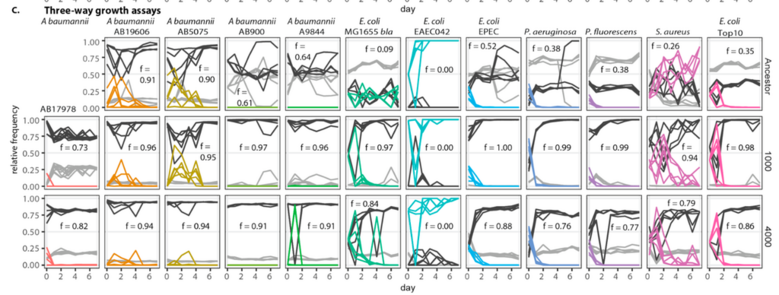2025-10-01 20:00:13
From the Wikipedia article about the selection process:
"Girls who pass these basic eligibility requirements are examined for the battis lakshanas, or "thirty-two perfections" of a goddess, which involves their bodies being stripped of all clothing and caressed by the priests....In addition to this, her hair and eyes should be as black as possible, and she should have dainty hands and feet, small and well-recessed sexual organs, and a set of twenty teeth."
2025-10-31 14:15:15
Experimentally co-evolved E. coli and yeast achieve stable coexistence — and the coevolved E. coli, but not the yeast, is able to resist invasion by other bacterial strains
https://doi.org/10.1007/s00248-025-02618-w
2025-09-30 16:00:05
topology: Internet AS graph (2004)
An integrated snapshot of the structure of the Internet at the level of Autonomous Systems (ASs), reconstructed from multiple sources, including the RouteViews and RIPE BGP trace collectors, route servers, looking glasses, and the Internet Routing Registry databases. This snapshot was created around October 2004.
This network has 34761 nodes and 171403 edges.
Tags: Technological, Communication, Unweighted, Multigraph, Timestamps
2025-09-30 19:32:54
Rudolf Rocker’s writings remind me that holding fast to my own convictions, even when they’re unpopular, is an act of freedom itself.
His life shows me that resisting conformity and staying rooted in my own political beliefs isn’t just stubbornness, it’s a way of defending individuality and dignity against the weight of authority.
#Anarchism
2025-09-30 14:38:21
Intra-request branch orchestration for efficient LLM reasoning
Weifan Jiang, Rana Shahout, Yilun Du, Michael Mitzenmacher, Minlan Yu
https://arxiv.org/abs/2509.24957 https://
2025-09-30 12:04:21
Real-Time Power electronics Control and Monitoring with TI F28379D DSC and GUI Composer
Ilyas Bennia, Lotfi Baghli, Ehsan Jamshidpour, Abdelkader Mechernene, Jean-Philippe Martin, Driss Yousfi
https://arxiv.org/abs/2509.25008
2025-11-30 10:35:45
RIP Tom Stoppard. I’m grateful for his masterpiece "Arcadia", and proud of the work we did on it. It's a deep reflection on the nature of truth, love, and art, those who run roughshod over it - very relevant today.
https://theater-u34.de/arkadien/
2025-09-02 03:00:56
trec: TREC collection (2010)
A bipartite network of documents and the words they contain, extracted from NIST's Text Retrieval Conference (TREC) disks 4 and 5, from 2010. These archives contain material drawn from the Financial Times Ltd., the Congressional Record of the 103rd Congress, the Federal Register, the Foreign Broadcast Information Service, and the Los Angeles Times newspaper.
This network has 1729302 nodes and 83629405 edges.
Tags: Informational, Language, Un…
2025-11-29 03:39:47
2025-11-01 17:00:05
wiki_rfa: Wikipedia RfA voting network (2013)
The set of all votes on Requests for Adminships (RfA), from 2003 to May 2013, represented as a directed, signed network in which nodes represent Wikipedia members and edges represent votes.
This network has 11381 nodes and 198275 edges.
Tags: Social, Relationships, Signed
https://











